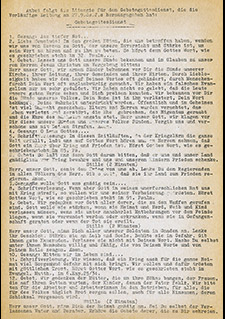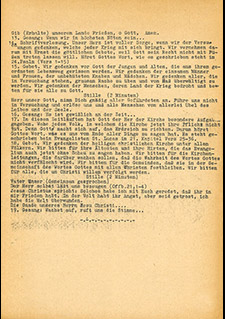2nd Provisional Church Government Prayer Liturgy
After the Confessing Church had split into two camps, the “intact” regional churches and a “radical” wing, in 1936, two governing bodies, the “Council of the Evangelical Lutheran Church in Germany” (Luther Council) and the Second Provisional Church Government, were formed in the spring of 1936.
The “Sudeten Crisis” in September of 1938 bred expectations of an imminent outbreak of a war. In response to this development, Karl Barth, a theologian at the University of Basel, showed his solidarity with the Czechs in a letter. Shortly afterward, the Second Provisional Church Government issued a liturgy of prayer, which, in the face of an impending war, was supposed to be prayed at church services on September 30, 1938. It gave expression to personal failure, awaited God’s aid and formulated hope for peace.
A war was averted at the last minute by the Munich Agreement and the liturgy did not come to be used. None of that altered the violent reaction on the part of Nazi propaganda: The SS newspaper “Das Schwarze Korps” accused them of treason and sabotage and labeled the whole thing dirty mind games of the politicized clergy. The Second Provisional Church Government, in turn, subsequently distanced itself from Karl Barth’s letter and repudiated the charge of treason.
The Reich Ministry of Church Affairs increasingly exerted pressure and the bishops of the “intact” regional churches were forced to issue a statement in which they disapproved of the liturgy of prayer for religious and patriotic reasons. Consequently, the Second Provisional Church Government was all but completely isolated. Its staff had to suffer through interrogations and was subjected to travel restrictions. A settlement between the Confessing Church’s two camps had become increasingly remote.
Source / title
- © Ev. Arbeitsgemeinschaft für Kirchliche Zeitgeschichte München, C 3. 25


